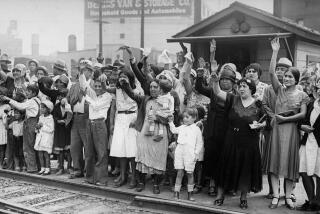Putting a human face on illegal immigration
I became an English tutor by accident.
A few months out of college and feeling lonely and bored in a new town 3,000 miles from my family and friends, I volunteered to teach illiterate adults to read. It was something to do, somewhere to go other than my moldy attic apartment after work in a windowless office in Aberdeen, Wash., a foggy mill town of 16,000 people best known as the hometown Kurt Cobain slammed in his songs.
To my dismay, the volunteer coordinator at Grays Harbor Community College declined my offer. But she offered another option.
“What about the ESL classes?” she asked. “They’re full and not many people want to tutor immigrants.”
The only immigrants I knew well were college classmates who’d come on student visas. I was ambivalent about the idea of tutoring people who might be in the U.S. illegally.
Yet with nothing else to do in the evening, I agreed to try it. I quickly discovered that I had much in common with my new students. Like me, they were new to Aberdeen, new to Washington, still trying to figure out how to stay dry in one of the wettest places in the United States.
Aberdeen’s immigrants do backbreaking work tearing salal from the rainforest floor and selling the vines ($50 for a day’s work) to dealers, who send them to florist shops around the country. They pound Dungeness crabs with mallets and pluck their tender meat, or shuck oysters, or slice fish. Some man ocean-bound fishing boats with names like Tricia Rae and Crystal Marie.
By the time I arrived in Aberdeen in 2002, thousands of immigrants were sleeping stacked in apartments and trailers throughout Grays Harbor County. And there were tensions.
Immigrant children crowded local schools, and their parents did not understand letters sent home in English and missed parent-teacher conferences and back-to-school nights. Many out-of-work loggers resented their taxes going to pay for the kids to learn English.
The immigrants, many of them Catholic, wanted places to worship, but churches were reluctant to offer services in Spanish. Hiring bilingual preachers and paying to keep chapels open for extra services would cost money, and it was assumed these immigrants would not be dropping much in the collection basket.
In loud voices and on the opinion pages of the Daily World, the local paper, residents railed against the newcomers for not learning English. But as I soon found out, they were certainly trying.
Every evening, exhausted after a day of work, men and women came to a baby blue schoolhouse in Aberdeen to learn.
I met them on the bottom floor: Level 1 English.
While the teacher taught salutations and vocabulary for clothing and food, I sat with the newest students and tried to help them sound out the letters to form the words in the language of their new home.
In my halting Spanish, I pointed out what I could: “Autobús. Tienda para comida. La escuela para tus niños.”
Sometimes they brought in documents — job applications, bills, report cards — and I tried to make sense of them. They laughed when my Rs fell flat and refused to roll, and I teased them about the “hobs” they were applying for.
We drew maps of grocery store aisles and took a field trip to Safeway. We studied bus routes and U.S. currency. For Thanksgiving, we baked a pumpkin pie.
They entertained me with stories of Mexico and introduced me to pan de dulce, and sent me messages from their new Hotmail accounts. I soon felt less alone, more rooted.
I usually walked the half-mile from class to my apartment, but on rainy nights, a beat-up van full of Mexican men never failed to stop on the road beside me. The backdoor would clang open and I would climb in, grateful.
After volunteering at the school for a couple of years, I arrived one evening to find the room nearly empty.
Immigration officers had stormed a fish processing plant that day, blocking doors and trapping scores of people with fish entrails on their hands and clothes. Some escaped. I don’t know how. Others were loaded into trucks and taken away.
In class that day, a man with pointy cowboy boots and a torn Nike windbreaker clacked over to me. I knew he had kids, two girls.
“Cat-lean,” he said, searching my brown eyes. “How we know they no come here?”
I looked at the man, at all he had to lose. I had no words.
I could not promise him that our school would not be raided. I thought it was safe, but how could I really know? He would not be back to class, I assumed, but I knew he would be around, hunched over a bag of salal in the rainforest or dropping nets into the icy ocean in exchange for wages teenagers would turn up their noses at.
Although immigration raids and laws such as Arizona’s SB 1070 push illegal immigrants underground, away from hospitals and banks and English classes, they do not force them out of the country. As long as there is hope — jobs, education, a future for the children — illegal immigrants, my students included, will stay.
An hour after arriving to a nearly empty class, I left school and stepped into the rain. I walked slowly, searching the darkened streets for a rusty van with a busted headlight.
I arrived home, soaked.
Kaitlin Manry, a freelance writer, now lives in Riverside.
More to Read
Sign up for Essential California
The most important California stories and recommendations in your inbox every morning.
You may occasionally receive promotional content from the Los Angeles Times.










